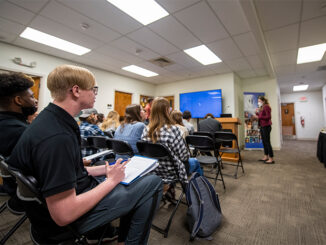
By Maddie Garvis//
You probably have witnessed an instance of bullying, homophobia, racism, transphobia, sexism, sexual violence, or harassment at some point and were unsure of what you could do to help.
Educating yourself on ways to intervene as a bystander can help give you the power to prevent and reduce potential harm in these types of situations.
The steps to successfully intervene as a bystander are:
Step 1: Notice the situation (Trust your gut. If something feels wrong it probably is.)
Step 2: Decide if intervention is needed (It’s important to be aware of our own biases during this step so we don’t assume a situation is harmful just because of the people involved.)
Step 3: Assume the responsibility of intervening.
Step 4: Decide on a method of safe and effective intervention.
Step 5: Take action.
When considering how to intervene in a potentially harmful situation, it’s important to remember that your safety and the safety of others is always the most important thing.
Here are some of the most common methods of intervention that can be used to deescalate potentially harmful situations:
Distracting:
This method focuses on diverting the attention of the person causing the harm so the person at risk of being harmed can get away. This could include using humor, pretending to know one of the people involved and starting a conversation with them, or doing something like asking for directions or help with something.
Making your presence known:
This method involves showing those involved in a potentially harmful situation that you’re there to witness what’s happening. This simple intervention tactic can discourage someone from harming another person if they know someone is there to see it. It also lets the person at risk of harm know that they have an ally in the situation.
Group intervention:
This method is useful in situations when you are uncomfortable trying to resolve a situation on your own and can make intervention safer for everyone involved. It involves teaming up with others who notice a potentially harmful situation and working together to diffuse the situation as a group.
Humanize:
This method involves pointing out how another person may be feeling during a potentially harmful situation, and asking the person causing the situation to think about how they would feel if the roles were reversed. You could also describe how you would feel if a similar situation happened to you.
Reach out for help:
In potentially harmful situations where you aren’t sure how to help, or you don’t think it’s safe to intervene, there’s the option to ask a more qualified person to help diffuse the situation. This is useful in instances where you don’t feel qualified or confident enough to try to resolve a situation on your own, so you bring the situation to the attention of someone more qualified.
One important thing to remember is that anyone can be an effective active bystander by safely intervening in what they see as potentially harmful situations.
The more that someone is educated on effective intervention skills, the more likely they are to feel comfortable intervening, and could possibly prevent violent or problematic behavior that could harm another person.
We all need to work together to make Hood a tolerant and welcoming place where everyone can feel safe regardless of their gender, race, age, religion, nationality, or sexuality.
There are confidential counseling resources available for students who wish to use them, contact at healthservices@hood.edu or Rev. Beth O’Malley for more information.
For more information about being a better active bystander and Hood’s Active Bystander Initiative, contact Nina Carr at carrn@hood.edu.



Be the first to comment